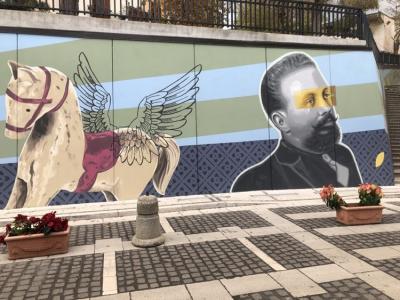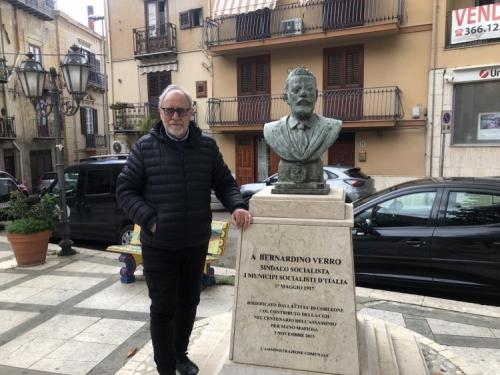Thirty years after Palermo Spring, Corleone's anti-Mafia renaissance continues

CORLEONE, Sicily – Thirty years after I first visited this hill town to report for The Times newspaper on school children, trade unionists and journalists rebelling against the Mafia, its centre has been transformed with a mural hailing both Catholic saints and a secular hero murdered by Cosa Nostra while the dazzling natural beauty of its surrounds is a burgeoning tourist attraction.
My guide during the visit, as when I first came to Corleone in 1992, at the height of the sinister powers of the ferocious Corleonesi clan of the Mafia, is Dino Paternostro, a crusading trade unionist and journalist who founded the anti-Mafia newspaper Città Nuove, a publication staffed by volunteers that survived having its offices burned down by mobsters in 1991 and repeated threats by hoodlums to the editor and his family. He proudly shows me the large mural in the Piazza Garibaldi that now pays homage to the two patron saints of the town, Leoluca and Bernardo, as well as to Bernardino Verro one of the best known of as many as 36 trade unionists murdered in Sicily by Mafia assassins. Verro was gunned down by the underworld in 1915.
Each of the 36 is honoured also by ceramic cobblestones with their names on dispersed around the city, recalling the bronze miniature stones inserted among cobbles in Rome to recall Romans sent to Nazi death camps in the Second World War.
Since Dino and I first met here, many of Corleone’s most notorious sons such as Toto Riina, the ‘boss of bosses,’ and his successor at the head of Cosa Nostra, Bernardo Provenzano, have died after being captured following decades on the run. The death this year of Trapani mafia kingpin Matteo Messina Denaro and the arrest of many of his supporters has further diminished the power of organised crime on the island but a resurgence of right-wing politicians with alleged links to the Mafia, taking back senior positions at Palermo city hall and the Sicilian regional parliament, is a reminder that the struggle against the mob is not yet over.
Many other Cosa Nostra bosses are languishing in prison but the state has yet to subdue the Calabrian version of the Mafia, the Ndranghetà, and the vicious Naples crime gangs of the Camorra. Throughout the past decades Dino has continued tirelessly to spread Sicilians’ pride in the magnificent example given by the trade unionists who paid the ultimate price for organising peasants against the big landowners who used Mafiosi to break up demonstrations for land reform and decent wages.
In 1992 I quoted Dino in The Times telling me “Condemning the Mafiosi in Milan, Rome and Palermo is relatively easy. But in Corleone where everyone knows everyone else, it is an achievement. A process of renewal has begun.” Under Dino’s inspired leadership then as an independent local councilor, hundreds of Corleone’s inhabitants became prominent in resistance to the mob and its code of silence. Sicilians were surprised when the Corleone paris church held a special mass to commemorate the death of Judge Paolo Borsellino.
Afterwards the congregation of 300 staged a torchlight march through the medieval streets. As many as 800 Corleone school pupils and 40 teachers held a spontaneous demonstration against judge Giovanni Falcone’s killing.
Educational authorities then asked all Corleone school pupils to write letters to the men of the Mafia. One class of nine and 10-year-olds wrote:
“We want to tell you, mafiosi, that tomorrow many of us children who attend primary school will be magistrates and journalists, policemen and teachers. We will try to use the powers at our disposal to defeat violence and death.”
In the offices of his Città Nuove newspaper during my latest visit, Dino gives me copies of two books he has written about the union martyrs. The walls of the office are decked with photos of Dino marching with national union leaders such as Sergio Cofferato.
Corleone may never completely eradicate its popular association in the Anglò-Saxon world with the Godfather movie based on Mario Puzi's novel, that was filmed in part in the town, but the heroic efforts of its trade unionists and anti-Mafia crusaders are now deservedly better known.
jp


© COPYRIGHT ITALIAN INSIDER
UNAUTHORISED REPRODUCTION FORBIDDEN


